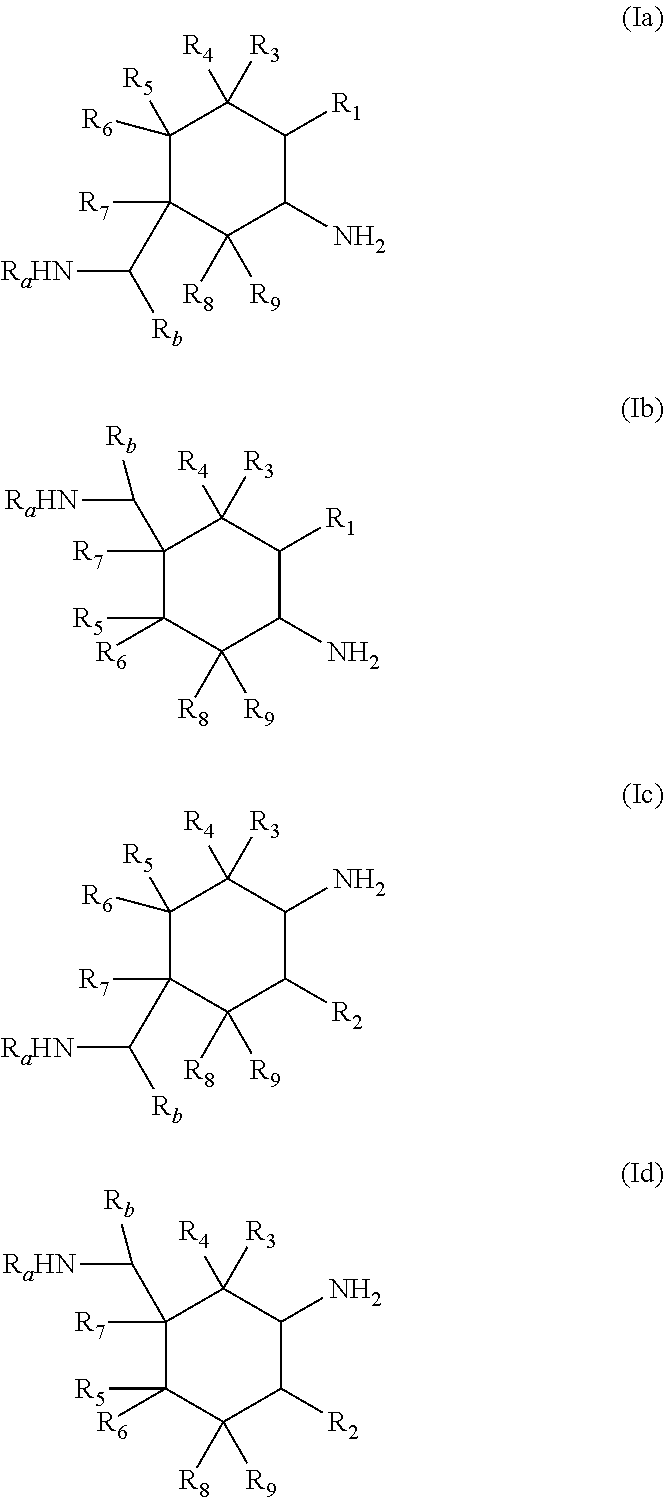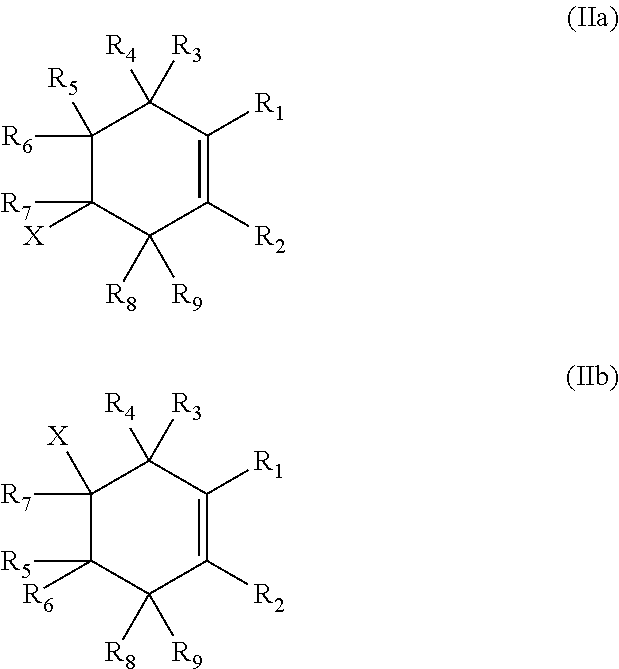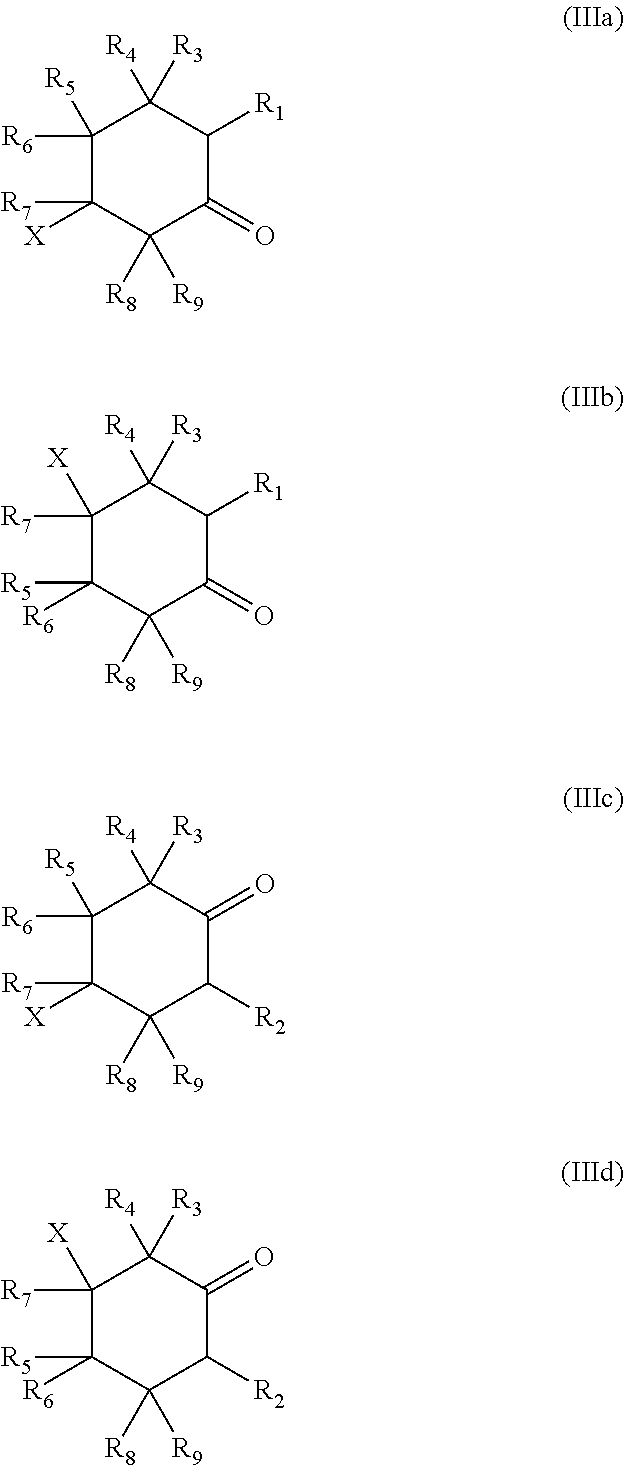Process for preparing cyclic diamines
a cyclic diamine and process technology, applied in the field of cyclic diamine preparation, can solve the problems of inconvenient and costly synthesis methods described in the prior art for preparing such cyclic diamines, and achieve the effect of simple and inexpensiv
- Summary
- Abstract
- Description
- Claims
- Application Information
AI Technical Summary
Benefits of technology
Problems solved by technology
Method used
Image
Examples
example 1
Preparation of 3-cyclohexenecarbonitrile
[0154]Acrylonitrile (800 g, 15.1 mol, purity >99%) was sucked from a laboratory bottle into a nitrogen-inertized and subsequently evacuated 3.5 l autoclave with overhead stirrer (2×6 stirrer blades). The bottle was, if appropriate, filled with toluene (200 g) which was sucked into the autoclave by the same path. 1,3-Butadiene (purity >99.5%) was injected at a pressure of 30 bar up to a concentration c. The stirring was adjusted to 1000 rpm and the autoclave was heated up to a temperature T. After t hours, the autoclave was cooled to 40° C. and then decompressed to ambient pressure. With the stirrer running, 250 l (STP) of N2 / h were introduced via a riser tube for 3 h in order to drive out the unconverted 1,3-butadiene. Volatile fractions were removed under reduced pressure (70 mbar, distillation temperature 50° C.). Distillation of the residue under reduced pressure (30 mbar, 100° C.) gave 3-cyclohexenecarbonitrile as a colorless liquid of >99...
example 2
Preparation of 3- or 4-oxocyclohexanecarbonitrile as a Mixture of cis and trans Isomers
[0157]A nitrogen-inertized and subsequently evacuated 1.2 l autoclave with an overhead stirrer (2×6 stirrer blades) was charged with 3-cyclohexenecarbonitrile (x) and toluene (y) in a ratio of x:y. 50 bar of N2O were injected, the mixture was stirred briefly (1400 rpm) and N2O was, if appropriate, injected repeatedly up to a pressure p. The autoclave was heated to an internal temperature T and stirred at this temperature for a time t. The autoclave was cooled, decompressed to ambient pressure, emptied and rinsed with toluene, and volatile fractions were removed from the combined organic phase under reduced pressure. The residue was distilled under reduced pressure. The isomer mixtures of 3- and 4-oxocyclohexanecarbonitrile (˜1:1) were obtained as a colorless liquid in a purity of 98%. The results of the tests are compiled in table 2.
[0158]
TABLE 2Ex.T [° C.]p [bar]t [h]x:yC(%)[a]S (%)[b]Notes2.1130...
example 3
Preparation of 3- and 4-aminomethylcyclohexylamine as a Mixture of cis and trans Isomers
[0160]The apparatus used consisted of two 270 ml high-pressure autoclaves with a gas inlet, a line for liquid ammonia and propeller stirrers, which were connected to one another via a line at the bottom of the autoclave such that the contents of the first reactor were transferable to the second reactor by means of elevated gas pressure.
[0161]A mixture of 3- and 4-oxocyclohexanecarbonitrile (27.8 g, 228 mmol) was introduced into the first autoclave and the autoclave was closed. After inertization with nitrogen, liquid NH3 (120 g, 7.06 mol) was pumped in. The mixture was then heated to 80° C. with stirring (500 rpm). This achieved a pressure of 50 bar. The second autoclave was initially charged with Raney cobalt 2724 from Grace in an amount which was washed with MeOH (3×20 ml), and the autoclave was closed and inertized. After 2 h, the mixture from the first autoclave was transferred into the secon...
PUM
| Property | Measurement | Unit |
|---|---|---|
| temperatures | aaaaa | aaaaa |
| pressure | aaaaa | aaaaa |
| temperature | aaaaa | aaaaa |
Abstract
Description
Claims
Application Information
 Login to View More
Login to View More - R&D
- Intellectual Property
- Life Sciences
- Materials
- Tech Scout
- Unparalleled Data Quality
- Higher Quality Content
- 60% Fewer Hallucinations
Browse by: Latest US Patents, China's latest patents, Technical Efficacy Thesaurus, Application Domain, Technology Topic, Popular Technical Reports.
© 2025 PatSnap. All rights reserved.Legal|Privacy policy|Modern Slavery Act Transparency Statement|Sitemap|About US| Contact US: help@patsnap.com



